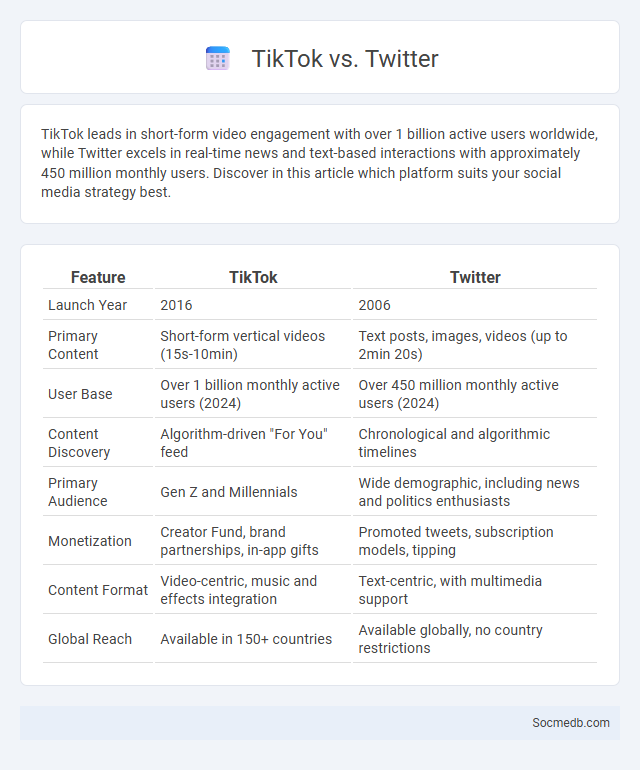
Photo illustration: TikTok vs Twitter
TikTok leads in short-form video engagement with over 1 billion active users worldwide, while Twitter excels in real-time news and text-based interactions with approximately 450 million monthly users. Discover in this article which platform suits your social media strategy best.
Table of Comparison
| Feature | TikTok | |
|---|---|---|
| Launch Year | 2016 | 2006 |
| Primary Content | Short-form vertical videos (15s-10min) | Text posts, images, videos (up to 2min 20s) |
| User Base | Over 1 billion monthly active users (2024) | Over 450 million monthly active users (2024) |
| Content Discovery | Algorithm-driven "For You" feed | Chronological and algorithmic timelines |
| Primary Audience | Gen Z and Millennials | Wide demographic, including news and politics enthusiasts |
| Monetization | Creator Fund, brand partnerships, in-app gifts | Promoted tweets, subscription models, tipping |
| Content Format | Video-centric, music and effects integration | Text-centric, with multimedia support |
| Global Reach | Available in 150+ countries | Available globally, no country restrictions |
Introduction: The Social Media Battleground
Social media platforms have transformed global communication by enabling instant information sharing and community building. Leading networks like Facebook, Instagram, Twitter, and TikTok compete fiercely for user engagement, advertising revenue, and data dominance. This digital battleground shapes public opinion, marketing strategies, and the future of online interaction.
TikTok Overview: Features and Audience
TikTok boasts a dynamic platform with unique features like short-form videos, engaging filters, and viral challenges, appealing primarily to Gen Z and Millennial users. Its algorithm-driven feed promotes personalized content discovery, boosting user engagement and content virality. With over one billion monthly active users, TikTok is a dominant force shaping social media trends and digital marketing strategies.
Twitter Overview: Features and Audience
Twitter offers real-time microblogging with features like Tweets, retweets, hashtags, and trending topics that enable instant sharing and discovery of content. The platform's diverse audience includes journalists, influencers, businesses, and everyday users who engage in conversations around news, entertainment, and social issues. Your ability to connect with a global audience makes Twitter a powerful tool for brand awareness and community building.
Content Formats: Video vs Text Dynamics
Video content garners 1200% more shares than text, making it a powerful tool for engaging your audience on social media platforms. Text formats excel in detailed storytelling and search engine optimization, providing depth and clarity that videos sometimes lack. Integrating both video and text strategically enhances content reach and maximizes user interaction in diverse social media environments.
Engagement Metrics: Measuring Success
Engagement metrics such as likes, shares, comments, and click-through rates are essential indicators of your social media success, reflecting how actively your audience interacts with your content. Tracking these metrics over time helps identify which posts resonate most, enabling you to refine your strategy for better reach and impact. Accurate measurement of engagement also provides valuable insights into audience preferences and behavior, driving informed decisions for content creation and marketing efforts.
Algorithm Differences: Reach and Visibility
Social media platforms use distinct algorithms influencing your content's reach and visibility, with Facebook prioritizing meaningful interactions and Instagram emphasizing timely, engaging posts. TikTok's algorithm focuses on personalized content discovery through user behavior analysis, while Twitter highlights real-time, trending topics to maximize exposure. Understanding these differences enables you to tailor your strategy for optimal audience engagement across each platform.
Cross-Platform Promotion Strategies
Cross-platform promotion strategies leverage multiple social media channels such as Instagram, Facebook, TikTok, and Twitter to maximize content reach and audience engagement. Utilizing platform-specific features like Instagram Stories, TikTok challenges, and Facebook Groups enhances user interaction and brand visibility. Consistent branding, tailored content formats, and strategic posting schedules increase overall campaign effectiveness across diverse social media ecosystems.
Brand Opportunities: Advertising and Influencer Marketing
Social media platforms offer extensive brand opportunities through targeted advertising and influencer marketing, enabling precise audience segmentation and engagement. Leveraging influencer partnerships enhances your brand's credibility and reach by tapping into authentic content created by trusted voices within niche communities. Data-driven ad campaigns on platforms like Instagram, TikTok, and Facebook maximize ROI by aligning messaging with user behaviors and preferences.
Challenges: Content Moderation and Virality
Social media platforms face significant challenges in content moderation due to the sheer volume of posts and the complexity of distinguishing harmful content from legitimate expression. The rapid virality of misinformation and harmful material exacerbates these difficulties, often outpacing moderation efforts and algorithmic controls. Effective moderation requires advanced AI tools combined with human oversight to balance free speech with community safety.
Conclusion: Choosing the Right Platform for Your Goals
Selecting the right social media platform depends on your specific goals, whether increasing brand awareness, driving website traffic, or engaging with a target audience. Each platform offers unique features and demographics, making it essential to align your content strategy with the audience's preferences and behavior. Prioritizing platforms that best match your objectives will maximize your reach and return on investment.
 socmedb.com
socmedb.com